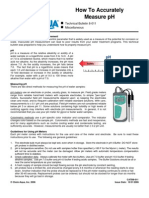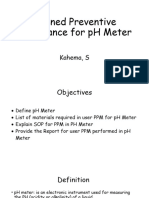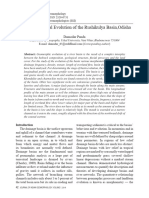Electrochemistry LC 6
Electrochemistry LC 6
Uploaded by
gondela puneethCopyright:
Available Formats
Electrochemistry LC 6
Electrochemistry LC 6
Uploaded by
gondela puneethCopyright
Available Formats
Share this document
Did you find this document useful?
Is this content inappropriate?
Copyright:
Available Formats
Electrochemistry LC 6
Electrochemistry LC 6
Uploaded by
gondela puneethCopyright:
Available Formats
LC -6 pH Metry - Principle – Applications.
Keywords Principle, applications and advantages of pH metric titrations
pH metric titrations
Principle: Here the basic principle is that when two electrodes are
kept in two solutions having different hydrogen ion concentration and the
electrodes are connected to a potentiometer and the solutions via salt
bridge, a small potential difference (EMF) can be observed. If the standard
EMF produced by hydrogen ion species of a known concentration is
known, the EMF can be measured by comparison and calibration. The pH
and EMF are related by the equation, pH = (EMF/0.00019837) T
Where ‘T’ is the absolute temperature.
Hence, pH value of the solution increases with the increase in
temperature
How to measure the EMF produced by Hydrogen ion species?
The measurements of pH are carried out with a glass electrode.
End point/ stoichiometric equivalence point in these titrations is measured
from the plot that is drawn for pH against volume of titrant. Model graphs
are given below.
Model Graphs:
Normal graph First derivative graph
Applications of pH metric titrations:
Water quality: pH meters are used to measure water quality in municipal water
supplies, swimming pools, and aquariums. They can also be used to monitor the
progress of natural processes that break down pollutants.
Agriculture: pH meters are used to test soil quality and water quality in agriculture.
Food industry: pH meters are used to ensure the quality and ratio of ingredients in
food products.
Pharmaceuticals: pH meters are used to evaluate the acidity or alkalinity of drugs and
to develop pharmaceutical drugs.
Medical diagnostics: pH meters are used in medical diagnostics and clinical
laboratories for a variety of applications, including quality control, enzyme activity
studies, and monitoring acid-base balance.
Biotechnology: pH meters are used in biotechnology departments to ensure that cells
maintain a constant pH so that enzyme reactions can take place.
Brewing: pH meters are used in the brewing of wine or beer.
Manufacturing: pH meters are used in manufacturing.
Cosmetics and detergents: pH meters are used to develop cosmetics and detergents.
Determination of concentration of strong acid using a strong base
A. Preparation of oxalic acid solution (primary standard solution)
B. Standardization of sodium hydroxide solution
C. Determination of strong acid using strong base
Please refer to page numbers 32-37 from R24 Chemistry lab manual for details
You might also like
- Still Beating by Jennifer: BookDocument3 pagesStill Beating by Jennifer: BooklishadNo ratings yet
- Experiment 4 - Potentiometric TitrationDocument11 pagesExperiment 4 - Potentiometric TitrationJoemer Absalon Adorna100% (3)
- PH METE1 RuffiDocument2 pagesPH METE1 RuffiNagiri MuraliNo ratings yet
- G.Chemistry Exp.7Document5 pagesG.Chemistry Exp.7sayar.emre888No ratings yet
- PH Meter - Principle, Parts, Procedure, Types, Uses, ExamplesDocument15 pagesPH Meter - Principle, Parts, Procedure, Types, Uses, Examplesनशीब सैन100% (1)
- Experiment No. 03 Determination of PH in Water Sample Using PH MeterDocument3 pagesExperiment No. 03 Determination of PH in Water Sample Using PH MeterUsman SubhaniNo ratings yet
- Methods of PH MeasurementDocument13 pagesMethods of PH Measurementambreensiddiqui981No ratings yet
- PH GuideDocument57 pagesPH GuideKshitij MehtaNo ratings yet
- Assesment Mu PH Meter - FirdausDocument14 pagesAssesment Mu PH Meter - FirdausMR. SOBBNo ratings yet
- QCQA TERMSDocument16 pagesQCQA TERMSKadam SachinNo ratings yet
- PH SensorDocument6 pagesPH SensorEspencer MartinNo ratings yet
- Assignment PH MeterDocument6 pagesAssignment PH Metermulticollection.multiNo ratings yet
- Test No.2 Potential of Hydrogen (PH) Aim of The Test:: Sanitary LaboratoryDocument2 pagesTest No.2 Potential of Hydrogen (PH) Aim of The Test:: Sanitary LaboratoryMahmood YounisNo ratings yet
- Siwes Presentation ModupeDocument19 pagesSiwes Presentation Modupejustkante kNo ratings yet
- Mesures (PH &e.c) Physico-ChimiquesDocument23 pagesMesures (PH &e.c) Physico-ChimiquesWafa TBNo ratings yet
- PH Meter – Definition, Diagram Working Principle, Types and ApplDocument13 pagesPH Meter – Definition, Diagram Working Principle, Types and ApplPankaj DholeNo ratings yet
- Temperature Compensation in PH Meter-A Survey: April 2015Document10 pagesTemperature Compensation in PH Meter-A Survey: April 2015Deepakrao Bornare PatilNo ratings yet
- Ph-Measurement: by MahithaDocument17 pagesPh-Measurement: by MahithaCH PurnimaRajeshNo ratings yet
- Report 4Document3 pagesReport 4Muhammad UsamaNo ratings yet
- PH Measurement-15.7.2014Document45 pagesPH Measurement-15.7.2014urvish_soniNo ratings yet
- Buffer and Common ion effect-1Document22 pagesBuffer and Common ion effect-1alilatifabbasiNo ratings yet
- PH MEASUREMENT AND BUFFER PREPARATIONDocument3 pagesPH MEASUREMENT AND BUFFER PREPARATIONJuan Carlos100% (1)
- CHM 204 Lecture Note FinalDocument44 pagesCHM 204 Lecture Note FinalMuhammed HarunaNo ratings yet
- PH MeterDocument5 pagesPH MeterSanjeevSharmaNo ratings yet
- EE lab Exp 1Document3 pagesEE lab Exp 1zarlish aliNo ratings yet
- Snehasis Ghosh - TTDocument14 pagesSnehasis Ghosh - TTSnehasis GhoshNo ratings yet
- PHDocument17 pagesPHHamzaNo ratings yet
- Instruments All PagesDocument21 pagesInstruments All PagesAbhinav SaiNo ratings yet
- PH MV White PaperDocument2 pagesPH MV White PaperDipNo ratings yet
- Env MonitoringDocument4 pagesEnv Monitoringrana72aliNo ratings yet
- PH Meter and Conductivity MeterDocument4 pagesPH Meter and Conductivity MeterjeysonmacaraigNo ratings yet
- Project ReportDocument21 pagesProject Reporthitesh.sahilNo ratings yet
- PH Meter FinalDocument12 pagesPH Meter FinalMustafa KamelNo ratings yet
- Regina 2016 PH in Fruit and vegetablesIS01842 1991 PDFDocument2 pagesRegina 2016 PH in Fruit and vegetablesIS01842 1991 PDFJorge Leandro SCNo ratings yet
- Topic 1Document45 pagesTopic 1precy.calusaNo ratings yet
- S.Y.B.sc. Instrumental Methods - II PH MetryDocument11 pagesS.Y.B.sc. Instrumental Methods - II PH MetryKushalpratap SinghNo ratings yet
- Project ReportDocument12 pagesProject Reportsahil.hitesh1979No ratings yet
- PH MeterDocument24 pagesPH Meterpygroup007No ratings yet
- PH Meter Maintenance and Repair: February 2013Document29 pagesPH Meter Maintenance and Repair: February 2013Peace OliverNo ratings yet
- PH Measurement and Buffer PreparationDocument6 pagesPH Measurement and Buffer PreparationJamesMartinDavidNo ratings yet
- How To Accurately Measure PHDocument2 pagesHow To Accurately Measure PHNibras100No ratings yet
- Water Pollution Continuous Monitoring Technology in JapanDocument3 pagesWater Pollution Continuous Monitoring Technology in JapanMayucious MayuNo ratings yet
- Sarthak Dadkar PIIAL Prac 4 PDFDocument5 pagesSarthak Dadkar PIIAL Prac 4 PDFAjuba AbujaNo ratings yet
- 11 PPM of PH MeterDocument13 pages11 PPM of PH Meterstumaini1200usdNo ratings yet
- PH Meter Universal IndicatorDocument4 pagesPH Meter Universal IndicatorNeeta PandeyNo ratings yet
- Biochem LabDocument10 pagesBiochem LabAlfie16No ratings yet
- CHE 221 Text 1Document19 pagesCHE 221 Text 1Candy PearlNo ratings yet
- USEPA2004 P HinsolidsDocument6 pagesUSEPA2004 P HinsolidsReiger RoyalNo ratings yet
- PH Measurements and CalibrationDocument68 pagesPH Measurements and CalibrationPrince John PrincipeNo ratings yet
- (An Exclusive Biotechnology Institute) : Training Report inDocument49 pages(An Exclusive Biotechnology Institute) : Training Report inDivya SharmaNo ratings yet
- #1-Lab Report_group 1_nd 732 LabDocument11 pages#1-Lab Report_group 1_nd 732 Labreivenkate.agonoy.educNo ratings yet
- Determining PH of Industrial WastewaterDocument11 pagesDetermining PH of Industrial WastewaterHammad zia 32No ratings yet
- Laboratory Details Central Instrument RoomDocument8 pagesLaboratory Details Central Instrument RoomDr. Anil LandgeNo ratings yet
- Section6 4 PDFDocument27 pagesSection6 4 PDFJon PaulNo ratings yet
- USP791 PHDocument4 pagesUSP791 PHJoaquín Andrés Aravena PérezNo ratings yet
- Instrumentation and Control in Bio ReactorsDocument4 pagesInstrumentation and Control in Bio ReactorsJonathan Arredondo50% (2)
- PH MeterDocument3 pagesPH MeterWalter100% (1)
- Experiment No: 2 PH Test ObjectiveDocument4 pagesExperiment No: 2 PH Test Objectivetheiconchaudhary579No ratings yet
- Chapter - 4 Electrochemical TechniquesDocument42 pagesChapter - 4 Electrochemical TechniquesDesale chaliNo ratings yet
- electrochemistry LC 5Document3 pageselectrochemistry LC 5gondela puneethNo ratings yet
- Pourbaix diagramDocument4 pagesPourbaix diagramgondela puneethNo ratings yet
- Corrosion 2Document9 pagesCorrosion 2gondela puneethNo ratings yet
- corrosion 1Document14 pagescorrosion 1gondela puneethNo ratings yet
- Comparison-of-SSPC-PA2-and-ISO 19840Document6 pagesComparison-of-SSPC-PA2-and-ISO 19840Ahmad FazriNo ratings yet
- Venturi Meter Example: P + P + ρ gh = P + ρ v P =Document4 pagesVenturi Meter Example: P + P + ρ gh = P + ρ v P =vackyvipinNo ratings yet
- Interview Que AnsDocument31 pagesInterview Que AnsMOHAMMAD FAIZAN AHMAD IRAQINo ratings yet
- Electric Vehicle NotesDocument29 pagesElectric Vehicle NotesVinod Babaleshwar100% (1)
- 2013 Product Keys For AutodeskDocument5 pages2013 Product Keys For Autodesktadele kassawNo ratings yet
- 02 ARM CompilerDocument46 pages02 ARM CompilerAn NgọcNo ratings yet
- Tutorial 8 - QuestionsDocument2 pagesTutorial 8 - QuestionsGowshika SekarNo ratings yet
- Agilent PursuitDocument4 pagesAgilent Pursuitgearfield07No ratings yet
- PC-MCUL32P pwm&bldc Protocol (압력연동형) 영문Document2 pagesPC-MCUL32P pwm&bldc Protocol (압력연동형) 영문Nhạt'sNo ratings yet
- Sustainable Business Model Innovation Scale Development ValidationDocument11 pagesSustainable Business Model Innovation Scale Development ValidationdewyekhaNo ratings yet
- Allen - Le Corbusier and Modernist Movement - The Carpenter Center - 2000Document13 pagesAllen - Le Corbusier and Modernist Movement - The Carpenter Center - 2000rdamico23No ratings yet
- Introduction To IR 2021Document40 pagesIntroduction To IR 2021Abdo AbaborNo ratings yet
- Water Glass AdvantagesDocument5 pagesWater Glass Advantagesgorane1155No ratings yet
- Catalogue Aluminium Foil ZhengyangDocument25 pagesCatalogue Aluminium Foil ZhengyangTarik ConceptNo ratings yet
- Aits 2324 Ot I Jeea TD Paper 2 OfflineDocument14 pagesAits 2324 Ot I Jeea TD Paper 2 OfflineAshish SharmaNo ratings yet
- Final Assessment Feb2022Document9 pagesFinal Assessment Feb2022aqilah030327No ratings yet
- Nuclear Chemistry: © 2012 Pearson Education, IncDocument56 pagesNuclear Chemistry: © 2012 Pearson Education, IncMaria FloresNo ratings yet
- Boolean AlgebraDocument10 pagesBoolean AlgebraFahad KhanNo ratings yet
- By: Amar RelanDocument51 pagesBy: Amar RelanmuskanNo ratings yet
- Nirma University: Speed Control of Motor Using TriacDocument7 pagesNirma University: Speed Control of Motor Using TriacAman KumarNo ratings yet
- Tarea 2Document2 pagesTarea 2Isai PerezNo ratings yet
- 2 - BGP Basics - HuaweiDocument44 pages2 - BGP Basics - HuaweinocNo ratings yet
- JoIG v7 (2019) p042 052 Panda Geomorphological Evolution of The Rushikulya BasinDocument11 pagesJoIG v7 (2019) p042 052 Panda Geomorphological Evolution of The Rushikulya BasinVaibhav VermaNo ratings yet
- Band KarateDocument3 pagesBand KaratejpNo ratings yet
- Board 134Document265 pagesBoard 134Yoseph BirruNo ratings yet
- TE-02(A)_TYM(P1)_07-08-2024_SolDocument22 pagesTE-02(A)_TYM(P1)_07-08-2024_Solvinodgodaralaptop7976No ratings yet
- ABRSM Grade Four Music TheoryDocument51 pagesABRSM Grade Four Music TheoryNuwemuramuzi Ian MartinNo ratings yet
- UFMFF8-30-1 Exam Paper 2016-2017Document8 pagesUFMFF8-30-1 Exam Paper 2016-2017Irfan MemonNo ratings yet
- Compressir Lubrication Theory DanfossDocument7 pagesCompressir Lubrication Theory DanfossSlavikNZNo ratings yet





























































































